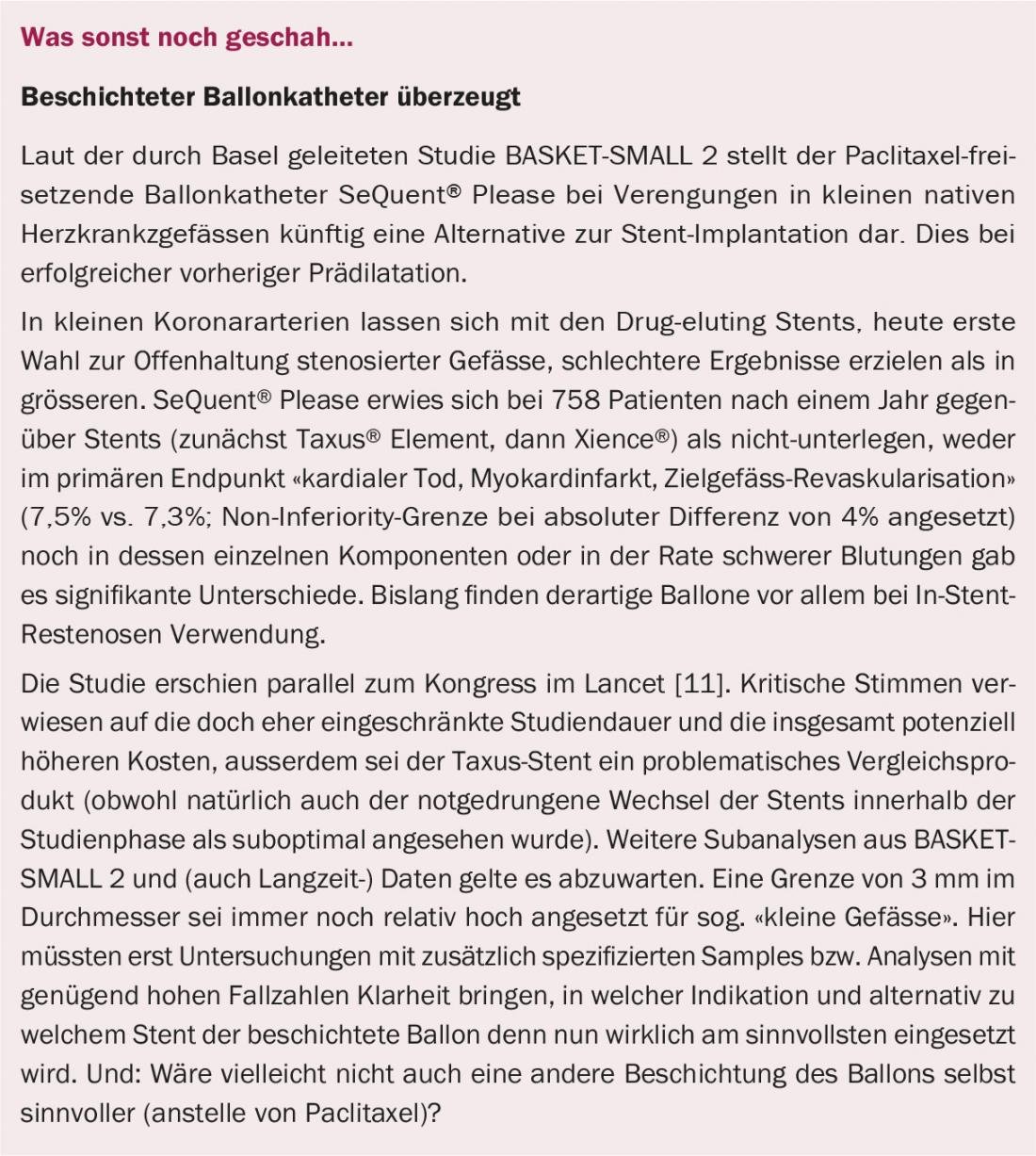After an unsuccessful trial several years ago, the Germans are now using TIM-HF2 to show for the first time a survival benefit from telemonitoring in heart failure. And: Safe weight loss – lorcaserin is also convincing cardiovascularly in CAMELLIA-TIMI-61.
Both telemonitoring in heart failure and weight loss drugs do not exactly look back on rosy times: in both areas, researchers have long had to contend with unsatisfactory or unclear study results and against critical voices from the scientific community.
For the first time, there are now solid data on the (long-term) cardiovascular safety of an appetite suppressant, namely lorcaserin. This is a selective serotonin 2C receptor agonist that has an appetite modulating effect. While the FDA had found the data sufficient back in 2012 to approve the drug for the long-term management of overweight and obese patients with a BMI of ≥30 or ≥27 kg/m2 in the presence of at least one comorbidity such as hypertension, type 2 diabetes, etc., the data were not sufficient to approve the drug for the long-term management of overweight and obese patients with a BMI of ≥30 or ≥27 kg/m2. As a complement to physical activity and dietary changes. Doubts about long-term cardiovascular and metabolic safety remained, however – in addition to unclear laboratory signals about a potential tumor risk and possible psychological side effects, this was one of the reasons for the critical interim assessment by the EMA’s expert committee, which ultimately led to the manufacturer’s withdrawal of the marketing authorization application in Europe. In Switzerland, where the substance is produced, lorcaserin is also not (yet) approved.
In the years before, various manufacturers had already launched similar products on the market. Given rising obesity rates worldwide, the potential of such drugs was considered enormous early on. However, the indication proved to be difficult. Since there are evidence-based alternatives, first and foremost of course lifestyle measures such as physical activity, nutritional counseling/change, psychological support, behavior modification and bariatric surgery, etc., for which positive effects have been described for a long time and which partly have a very good effect-side-effect profile (especially correctly performed exercise is almost unbeatable in this respect) [1], regulatory bodies always set the hurdle for such products particularly high. The benefits had to clearly exceed the (potential) side effects. And that had to be proven first in randomized-controlled trials. Some failed before marketing approval, others after, whether because of safety concerns of a cardiovascular or neuropsychiatric nature [2–4] or because of poorly accepted mechanisms of action that prevented profitable commercialization.
The observed side effects were diverse, ranging from pulmonary hypertension, heart rate increases, and valvular problems to increased rates of myocardial infarction and stroke to severe psychological complications and suicidal acts. In addition, there are two further problems: as soon as the medication is discontinued, the weight threatens to shoot up again (the classic yo-yo effect). A solid Lifeystyle “package of measures” is therefore a much safer value. In addition, most recent products do not have reliable long-term data to address safety concerns about hidden long-term effects. However, when they did become public, they were usually negative. It was also difficult to rely on other representatives, as they were either withdrawn from the market early on or had deviating modes of action. The market therefore remained difficult (especially in this country).
In the eyes of regulators, it was always critical that patient selection worked. The drugs were only allowed to reach individuals whose health risks (e.g., due to pronounced obesity and poorly functioning lifestyle programs) were so severe that, without drug support, the scales clearly tipped toward the harm side. Thus, even a small (additional) benefit of the substances was sufficient to achieve a positive balance. Nevertheless, their deployment was not without misgivings. Finally, for the drugs orlistat (available in Switzerland), liraglutide (also: Saxenda®), naltrexone/bupropion or even lorcaserin, which are approved in some countries for this indication, certain questions regarding (cardiovascular) long-term safety remained open – at least as far as the indication “obesity/overweight” is concerned. The latter compound now has the potential to change this situation.
Over 10 000 patients examined
The “rehabilitation” of a drug slimming agent in cardiovascular terms occurred at this year’s ESC Congress when the results of the CAMELLIA-TIMI-61 trial [5], published in parallel in NEJM, were presented. At the time, the FDA had required that lorcaserin undergo cardiovascular testing due to its structural similarities to (dex-)fenfluramine, which had been withdrawn from the market (all weight-loss drugs must now demonstrate this). The 12 000 randomized obese or overweight patients (the latter with existing atherosclerotic cardiovascular disease or multiple risk factors) received either lorcaserin or placebo. In general, the comorbid disease burden was high, with over half of the patients suffering from diabetes, and around 90% suffering from hyperlipidemia and hypertension. Noninferiority in the primary safety end point consisting of cardiovascular death, myocardial infarction, or stroke was previously tested in an interim analysis. This was done to exclude the possibility that the active substance exceeded the limit of a hazard ratio of more than 1.4. Provided noninferiority, we moved on to the efficacy end point, which was to demonstrate superiority in the aforementioned serious cardiovascular events plus heart failure, hospitalizations for unstable angina, or coronary revascularizations by the end of the trial.
Indeed, the safety endpoint showed 2.0% vs. 2.1% events annually (verum vs. placebo) during more than three years of follow-up, loosely achieving non-inferiority (HR 0.99; 95% CI 0.85-1.14; p<0.001). Thus, the active ingredient does not increase cardiovascular risk. In contrast, superiority in the extended endpoint was missed just as significantly, with annual rates of 4.1% vs. 4.2% (HR 0.97; 0.87-1.07; p=0.55). There were no safety signals of particular interest other than a significantly increased rate of severe hypoglycemia in the verum group – mainly in those with diabetes and appropriate medication at baseline – according to study authors. However, this needs to be specified somewhat: Symptomatic valvular heart disease was in the comparable range with 58 vs. 64 persons. However, in the echocardiography substudy, the percentage of new or progressive FDA-defined valvulopathies narrowly exceeded the placebo group (1.8% vs. 1.3%). Pulmonary hypertension was also not exactly equally distributed (slightly worse in verum group). Although the differences were not significant, it is worth continuing to monitor the development. For the time being, in view of the extensive randomized data, the substance can nevertheless be confidently said to have proven cardiovascular safety – this is far more than can be claimed for most other representatives in this indication (the positive LEADER study on liraglutide was conducted in a different indication and dosage). Lorcaserin is thus also recommended for weight reduction in cardiovascular risk patients.
Of course, weight control also improved significantly under the substance, as did blood pressure, lipids, glycemic control, and heart rate (overall moderate effects). Tumor risk was not increased. New-onset manifest diabetes was found slightly less frequently in patients with prediabetes at baseline on lorcaserin.
All clear?
Side note: The fact that superiority was not achieved in the efficacy endpoint may not be surprising. To date, there is no randomized-controlled trial of any other weight-loss drug or bariatric surgery that has demonstrated a reduction in serious cardiovascular events with sufficient power. With the Look-AHEAD study, these doubts recently extended to lifestyle interventions. A contributing factor in both Look AHEAD and CAMELLIA-TIMI-61 may have been the highly developed “background” medication, which makes it difficult to detect a significant difference in efficacy. Also, the study period, although quite long at three years, may still have been too short for weight reductions in this setting (the more than ten-year follow-up in Look AHEAD argues against this). That weight loss alone simply does not affect the endpoints in question is highly unlikely.
At the congress, the critical voices did not completely fall silent. Liraglutide (Saxenda®) in particular is seen as an extremely strong competitor among weight loss drugs. This is not only because of the aforementioned LEADER data (which showed a significant cardiovascular benefit, albeit in a different indication) [6], but also because of the even more significant reduced risk of manifest diabetes in patients with prediabetes at baseline (HR of 0.21 versus a HR of 0.81 in CAMELLIA-TIMI-61) [7]. According to the assessment of an independent external expert committee, 6 MACE occurred in liraglutide patients and 10 MACE in placebo patients in all studies with Saxenda® (HR 0.33; 0.12-0.90). Interesting side note: Patients in CAMELLIA-TIMI-61 were not allowed to take liraglutide at the 3 mg dose (Saxenda®) but were allowed to take the diabetes dose up to 1.8 mg (Victoza®).
The lack of publication of potential (therapy-associated) depression in CAMELLIA-TIMI-61 was also criticized, as the EMA had cited this in its 2013 position paper as one of the reasons why there were still doubts about the drug.
Telemonitoring in heart failure
Data on telemonitoring in heart failure, whether invasive with implants or not, are also complicated. Early signs and symptoms of decompensation should thus be registered and addressed accordingly. The topic has been the subject of controversial discussions for years, conclusive statements are difficult, skepticism still exists. In the (European) guidelines, telemonitoring has a rather subordinate status. Although various meta-analyses suggested a clinical benefit, the ESC said, the response from prospective clinical trials such as TELE-HF, TIM-HF, INH, WISH, and TEHAF was mixed [8]. TIM-HF showed some benefit of telemonitoring (better quality of life), but no benefit in overall survival as the primary endpoint despite the large effort. The IN-TIME approach to ICDs and the so-called CardioMems system – both implantation-based approaches – can be used in well-selected patients, according to the ESC.
Despite the overall failure of the TIM-HF study, Prof. Dr. med. Friedrich Köhler from Berlin and his team continued the approach in the follow-up study TIM-HF2, the results of which caused a sensation at this year’s ESC congress and in parallel in the Lancet [9]. The inclusion criteria were more narrow this time.
What is certain is that there are various forms of telemedicine. Each approach must be considered individually. In principle, however, telemonitoring can only function as part of a so-called Remote Patient Management (RPM) – consisting of a guideline-based therapy, training/self-empowerment and telemonitoring. In particular, the subgroup of patients hospitalized for heart failure seems to benefit, more specifically individuals with systolic chronic heart failure, or HFrEF, with NYHA II and III up to 12 months after hospitalization.
Thus, this population also constituted the 1538-patient sample of TIM-HF2. LVEF was ≤45% (but if it was higher, oral diuretics had to be taken). Cases with depression were specifically excluded. The RPM approach was based on the following key points:
- Hand-held measurement and subsequent transmission of blood pressure, ECG, weight, oxygen saturation once a day in addition to
- a brief clinical questionnaire, a monthly structured telephone interview, and
- generally a very close, 24/7 support of the patients by the telemedical service center.
However, the primary end point this time was time lost to unplanned cardiovascular hospitalizations or death. In percentage terms, this was 4.88% of the total study period of just over one year. This compared to 6.64% in the group with standard care alone (0.80; 95% CI 0.65-1.00; p=0.0460). Broken down to a year, this resulted in 17.8 vs. 24.2 lost days. The group of patients without telemonitoring thus spent a good week longer in hospital, as their symptoms were presumably discovered later and were already more decompensated. In contrast, telemonitoring triggered some potentially life-threatening admissions.
Overall survival was part of the secondary endpoints this time, along with cardiovascular survival. In the former there was a significant benefit of the approach, the risk reduction was 30% (HR 0.7), in the latter just not (p=0.0560).
The authors emphasized the active component of the approach, which includes not only monitoring or checking the limits, but also the interpretation of the overall picture by specialized nursing staff, general internal medicine/cardiology physicians in and outside of clinics, an active structured monthly follow-up, contacting in case of abnormal values, and an initiated change of medication if necessary – in the literal sense, a “management” of the disease and a holistic care of the patient (on the basis of an individualized risk profile), not just a gigantic “data kraken”. According to the authors, the patients themselves did not have any major problems in becoming active and collecting the data, not even the oldest among them (92 years). Together with the results of one of the first studies in this field, the TEN-HMS [10], with the same primary endpoint, there is a growing case for telemonitoring as a valid care strategy that can also improve overall survival. Of course, the approach is not suitable for every patient, as also shown by the patient selection in TIM-HF2. It is only considered for those who can be actively involved in the follow-up process (which is difficult for depressed individuals, for example).

Source: European Society of Cardiology (ESC) Congress, August 25-29, 2018, Munich, Germany.
Literature:
- Jensen MD, et al: 2013 AHA/ACC/TOS guideline for the management of overweight and obesity in adults: a report of the American College of Cardiology/American Heart Association Task Force on Practice Guidelines and The Obesity Society. J Am Coll Cardiol 2014 Jul 1; 63(25 Pt B): 2985-3023.
- Connolly HM, et al: Valvular heart disease associated with fenfluramine-phentermine. N Engl J Med 1997; 337: 581-588.
- James WPT, et al: Effect of sibutramine on cardiovascular outcomes in overweight and obese subjects. N Engl J Med 2010; 363: 905-917.
- Topol EJ, et al: Rimonabant for prevention of cardiovascular events (CRESCENDO): a randomised, multicentre, placebo-controlled trial. Lancet 2010; 376: 517-523.
- Bohula EA, et al: Cardiovascular Safety of Lorcaserin in Overweight or Obese Patients. NEJM August 26, 2018. DOI: 10.1056/NEJMoa1808721 [Epub ahead of Print].
- Marso SP, et al: Liraglutide and Cardiovascular Outcomes in Type 2 Diabetes. N Engl J Med 2016; 375: 311-322.
- Le Roux CW, et al: 3 Years of liraglutide versus placebo for type 2 diabetes risk reduction and weight management in individuals with prediabetes: a randomised, double-blind trial. Lancet 2017; 389: 1399-1409.
- Ponikowski P, et al: 2016 ESC Guidelines for the diagnosis and treatment of acute and chronic heart failure: The Task Force for the diagnosis and treatment of acute and chronic heart failure of the European Society of Cardiology (ESC). European Heart Journal 2016; 37(27): 2129-2200.
- Koehler F, et al: Efficacy of telemedical interventional management in patients with heart failure (TIM-HF2): a randomised, controlled, parallel-group, unmasked trial. The Lancet 2018. DOI: 10.1016/S0140-6736(18)31880-4 [Epub ahead of Print].
- Cleland JGF, et al: Noninvasive Home Telemonitoring for Patients With Heart Failure at High Risk of Recurrent Admission and Death: The Trans-European Network-Home-Care Management System (TEN-HMS) study. Journal of the American College of Cardiology 2005; 45(10): 1665-1666.
- Jeger RV, et al: Drug-coated balloons for small coronary artery disease (BASKET-SMALL 2): an open-label randomised non-inferiority trial. The Lancet 2018. DOI: 10.1016/S0140-6736(18)31719-7 [Epub ahead of Print].
CARDIOVASC 2018; 17(5) – published 11.9.18 (ahead of print).











